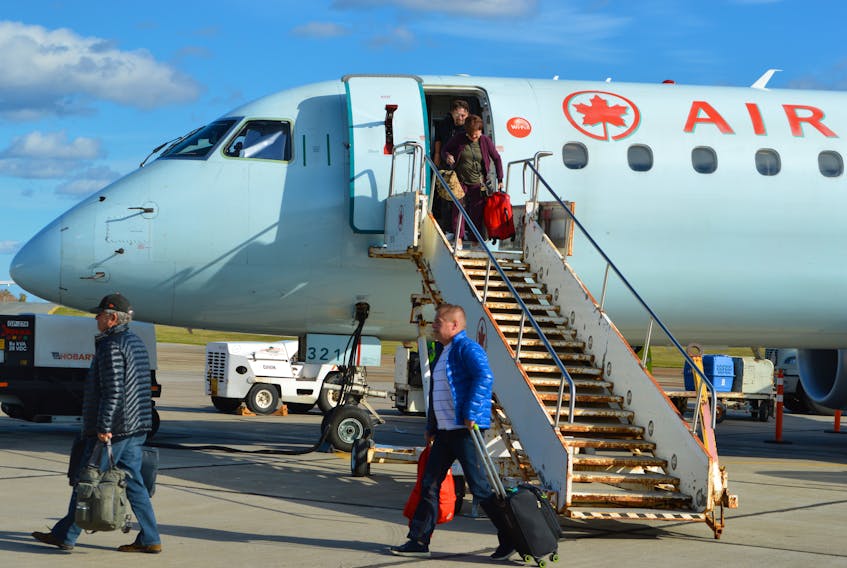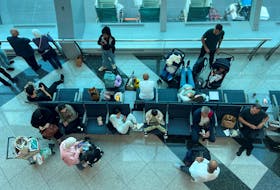SYDNEY, N.S. — It was a dream vacation that began with a nightmare.
Marcie Shwery-Stanley recently boarded an Air Canada jet by being carried up a steep set of stairs by three men.

“I was not only frightened to death, it was very demeaning,” said the Sydney woman who needs a wheelchair to get around. “It was a terrible experience and I’m looking into making a formal complaint.
“This is not acceptable. I’m hoping some exposure will get Air Canada to do something about this.”
Shwery-Stanley, who has been an advocate for people with disabilities for the past 37 years, said she travels frequently and is loyal to Air Canada. On Oct. 4 she headed for a trip to Las Vegas that started with a flight from Sydney’s J.A. Douglas McCurdy Airport to Toronto.
However, this was her first time flying from the Sydney airport on an Air Canada jet.
“The other planes — like a Dash 8 — have a ramp up to the door.”
Shwery-Stanley said she looked out and saw the jet and questioned how she would be boarded.
The ground attendant told her she had to get in what is called a “Washington chair.”
A Washington chair is described as an adjustable chair geared to allow someone to sit comfortably for more than eight hours.
“The chair is so small, I’d say it’s not even 18 inches square to sit on. I was totally shocked when they asked me to sit on it and strapped me in.”
Although there is a foot rest on it, Shwery-Stanley said because of knee surgery her knees don’t bend enough and the foot rest doesn’t go out far enough.
“To start off with the seat is very small which is scary and my feet were uncomfortable and just dangling the whole time they were wheeling me out.”
Shwery-Stanley said once she arrived at the foot of the stairs leading into the airplane, two men lifted the front of the chair and another lifted it from behind.
“They carried me up these steep stairs and everything is shaking going up,” she said. “I’m was just scared to death. It’s not just five or six steep stairs I’m guessing there were about 26.”
Shwery-Stanley said she is upset but also shocked that in this day and age someone with disabilities is taken on an aircraft this way and forced to experience that kind of trauma.
“There’s not these worries at larger airports as there are bridges linking the airport with the plane,” she added.
“It was also very demeaning with everyone looking at you.”
But she’s not upset at the Air Canada staff in Sydney. She knows they they don’t make these boarding decisions and tried their best.
Back in the 1990s, Shwery-Stanley said she was one of the people advocating for people with disabilities in regard to air travel and that’s when they came out with the passenger assistance lift.
Basically, she said, the steps would be inside the plane and there was a type of lift to transport someone with disabilities to the airplane door, like a forklift.
“That was back in the Nineties and here we are in 2018 and they don’t have anything,” she said.
“1981 was the International Year of the Disabled and we still have this? It’s not a very good message Air Canada — as a corporate body — is sending out to Canadians.”
In a few days she will be returning home from her trip.
“I’m so worried I’ll have to go back down those steps the same way.”
In an email response to questions from the Post regarding this incident, Isabelle Arthur, a spokesperson for Air Canada, said Air Canada takes its responsibilities to transport passengers with disabilities seriously.
“We certainly understand this customer’s concerns and are reviewing options to improve our service for customers with special accessibility requirements when flying from Sydney, Nova Scotia,” she said.
Officials at the Sydney airport say Air Canada and Westjet both contract the ground handling company to provide ground handling services. The airlines and the ground handling company work together to ensure that any equipment required to service their aircraft is on site and available.
Shwery-Stanley said she’s happy the Federal Canadians with Disabilities Act is in the works, as more legislation is needed to ensure people with disabilities don’t have to endure such barriers and action is taken when corporations don’t follow it.
Air travel is under federal jurisdiction.
“With the demographics here, there are going to be more people who need this type of assistance.”
Ottawa is introducing Bill C-81, the Accessible Canada Act: An Act to Ensure a Barrier free Canada, which was tabled on June 20, 2018.
According to information on the bill on the Government of Canada website, if passed, Bill C-81 would benefit all Canadians — especially Canadians with disabilities —by helping create a barrier-free Canada.
In putting together the bill, government officials conducted consultations with the community to find out about their priorities for accessibility. The key areas identified included programs and service delivery, employment, the built environment, information and communications technology, procurement, and transportation.
The federal government says once passed, Bill C-81 would give the federal government the authority to work with stakeholders and Canadians with disabilities to create new accessibility standards and regulations that would apply to sectors in the federal jurisdiction, such as banking, telecommunications, transportation industries like air and rail, and the Government of Canada itself.









